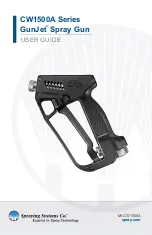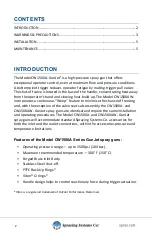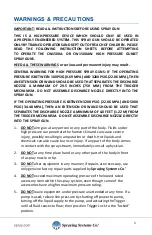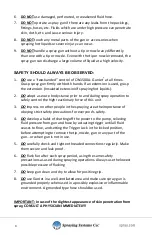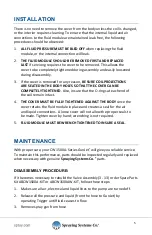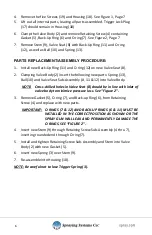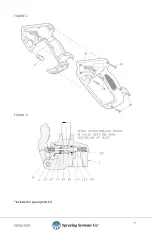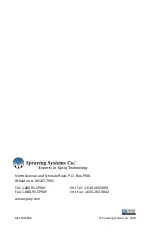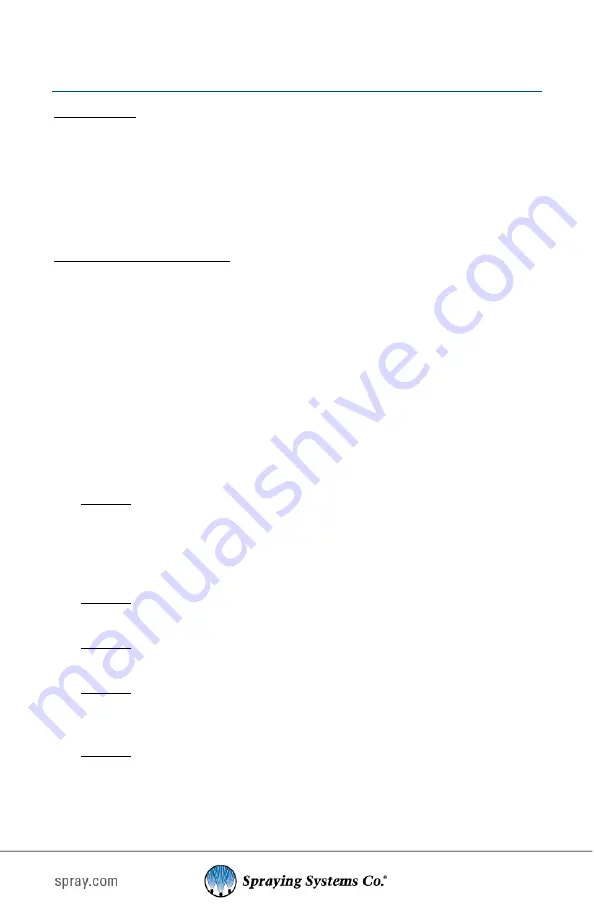
3
WARNINGS & PRECAUTIONS
IMPORTANT: READ ALL INSTRUCTIONS BEFORE USING SPRAY GUN
THIS IS A HIGH-PRESSURE DEVICE WHICH SHOULD ONLY BE USED IN
A PROPERLY ENGINEERED SYSTEM. THIS SPRAY GUN SHOULD BE OPERATED
ONLY BY TRAINED OPERATORS AND KEPT OUT OF REACH OF CHILDREN. PLEASE
READ THE FOLLOWING INSTRUCTION SHEETS BEFORE ATTEMPTING
TO OPERATE THE CW1500A- OR CW1500AW- HIGH PRESSURE GUNJET
SPRAY GUNS.
HEED ALL THESE WARNINGS or serious and permanent injury may result.
GENERAL WARNING FOR HIGH PRESSURE SPRAY GUNS: IF THE OPERATING
PRESSURE IS BETWEEN 100 PSIG (0.69 MPA) AND 3200 PSIG (22.06 MPA), THEN
AN EXTENSION OR WAND SHOULD BE USED THAT SEPARATES THE DISCHARGE
NOZZLE A MINIMUM OF 29.5 INCHES (750 MM) FROM THE TRIGGER
MECHANISM. DO NOT ASSEMBLE DISCHARGE NOZZLE DIRECTLY INTO THE
SPRAY GUN.
IF THE OPERATING PRESSURE IS BETWEEN 3200 PSIG (22.06 MPA) AND 5000
PSIG (34.48 MPA), THEN AN EXTENSION OR WAND SHOULD BE USED THAT
SEPARATES THE DISCHARGE NOZZLE A MINIMUM OF 4.0 FEET (1.22 M) FROM
THE TRIGGER MECHANISM. DO NOT ASSEMBLE DISCHARGE NOZZLE DIRECTLY
INTO THE SPRAY GUN.
1.
DO NOT
aim gun at any person or any part of the body. Fluids under
high pressure can penetrate the human skin and can cause severe
injury, possibly resulting in amputation or death. Hot liquids and
chemicals can also cause burns or injury. If any part of the body comes
in contact with the spray stream, immediately consult a physician.
2.
DO NOT
at any time place hand or any other part of the body in front
of a spray nozzle or tip.
3.
DO NOT
alter equipment in any manner; if repairs are necessary, use
only genuine factory repair parts supplied by
Spraying Systems Co
.
®
4.
DO NOT
exceed maximum operating pressure of the lowest rated
accessory item within the spray system, even though some of the
accessories have a higher maximum pressure rating.
5.
DO NOT
leave equipment under pressure unattended at any time. If a
pump is used, relieve line pressure by shutting off power to pump,
turning off the liquid supply to the pump, and actuating the Trigger
until all fluid ceases to flow; then position Trigger Lock to the “locked”
position.

